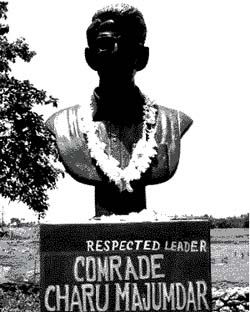Apr 18, 2025
Apr 18, 2025
Most dangerous is that watch
Which runs on your wrist
But stands still for your eyes.
Most dangerous is that eye
Which sees all but remains frostlike,
Most dangerous is the moon
Which rises in the numb yard
After each murder,
But does not pierce your eyes like hot chilies. ' Paash, A Naxalite Poet
During the summer holidays in Gwalior, we all went to my grandmother home in Shibpur in Howrah to escape the extreme heat of Madhya Pradesh. During one such visit, we found the walls of her house and adjoining houses plastered in red with slogans, 'Naxalbari Laal Saalam'. As a young boy unaware of the politics of that time in Bengal, I had frequently asked my father and uncles about the slogans and graffiti which they always declined to explain. Nobody had the courage to whitewash those walls.
Many years later, North East India became my favorite tramping grounds and driving long distances through little hamlets on my way to Bhutan or Along was more frequent. Visiting Naxalbari became a reality during that time.
But the explosive ingredients had long fizzled off and Naxalbari I found to my great disappointment just a small village like any other village in the Darjeeling district. The ghosts of Naxalbari could not be suppressed and curiosity brings thousands of people like me just to feel the soil or try to find a tiny ember of a revolution within the tea plantations and villages of that area.
The Mechi River lies close to it and across it lies Nepal. Farm lands, tea estates and forests dot this fertile geographical part of Darjeeling district. The large villages in the region are Buraganj, Hatighisha, Phansidewa and Naxalbari.
It all started in May 23 1967. The landless and poor peasants of Jharugaon village raised their bow and arrows. The attacking police hordes were met with a shower of arrows, spears, stones. An inspector was killed, the rest fled. The Naxalbari armed struggle that was to become a historic turning point in Indian politics, had begun.
 At the entrance to Naxalbari, a Kargil martyr's statue stands. The statue looks out of place in the village of Naxalbari. The sculptor sold it to government who thought of it erecting it there just to divert the mind from a history that is part of this place.
At the entrance to Naxalbari, a Kargil martyr's statue stands. The statue looks out of place in the village of Naxalbari. The sculptor sold it to government who thought of it erecting it there just to divert the mind from a history that is part of this place.
A dusty path leads to the settlement of 30,000-odd people sharing borders with Nepal and Bangladesh. There is no development here, the highways are pock marked and the peasants look poorer. The illegal immigrants from Bangladesh and Nepal do not know anything about this movement nor do they care to do so. The main occupation seems to be smuggling of essential goods through Nepal and Bangladesh borders.
A lone unkempt statue of Comrade Charu Mazumdar stands. The children of the village don't know anything about him.
26-Apr-2009
More by : Dr. Amitabh Mitra